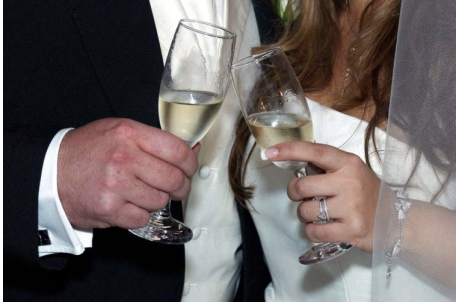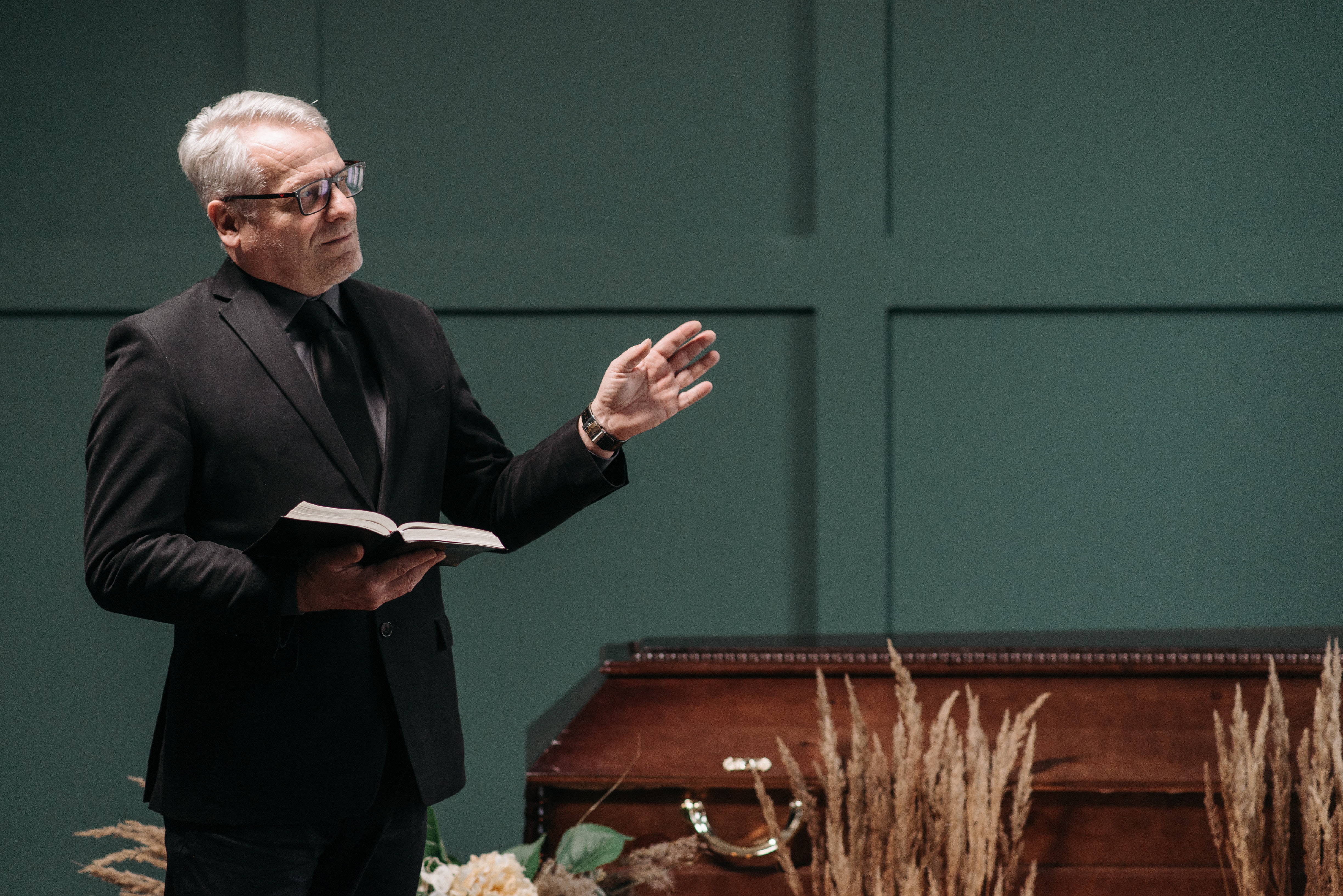17.3: Types of Special Occasion Speeches
- Last updated
- Save as PDF
- Page ID
- 107439
Unlike the informative and persuasive speeches you were required to give, special occasion speeches are much broader and allow for a wider range of topics, events, and approaches to be employed. Since you are like to give many special occasion speeches in your life, we want to cover everything you might need to know to give a good one.
Speeches of Introduction
The first type of special occasion speech is the speech of introduction, a mini-speech that introduces another speaker and their speech. Just like any other speech, a speech of introduction should be a complete speech and have a clear introduction, body, and conclusion—and you should try to do it all in under two minutes. This brings up another “few things are worse” scenario: an introductory speaker who rambles on for too long or who talks about themself instead of focusing on the person being introduced.
For an introduction, think of a hook that will make your audience interested in the upcoming speaker. Did you read a news article related to the speaker’s topic? Have you been impressed by a presentation you’ve heard the speaker give in the past? You need to find something that can grab the audience’s attention and make them excited about hearing the main speaker.
The body of your speech of introduction should be devoted to telling the audience three things:
- about the speaker’s topic,
- why the speaker is qualified,
- and why the audience should listen,
Notice we now have our three main points. First, tell your audience in general terms about the overarching topic of the speech. Most of the time as an introducer, you’ll only have a speech title and maybe a paragraph of information to help guide this part of your speech. That’s all right. You don’t need to know all the ins and outs of the main speaker’s speech; you just need to know enough to whet the audience’s appetite. Next, you need to tell the audience why the speaker is a credible presenter on the topic. Has the speaker written books or articles on the subject? Has the speaker had special life events that make him or her qualified? Lastly, you give a brief explanation to the audience why they should care about the upcoming speech. The outline can be adjusted; for example, you can give the biographical information first, but these three areas should be covered.
The final part of a good introduction is the conclusion, which is generally designed to welcome the speaker to the platform. Many introducers will conclude by saying something like, “I am looking forward to hearing how [Speaker's Name]'s advice and wisdom can help all of us today, so please join me in welcoming [Speaker Name].” At this point, you as the person introducing the speaker are “handing off” the speaking duties to someone else, so it is not uncommon to end your speech of introduction by clapping as the speaker comes on stage or shaking the speaker’s hand.
Award Speeches
Presentation, Acceptance, and Dedication are all speeches you make when someone or something is getting an award or honor.
Speeches of Presentation
The second type of special occasion speech is the speech of presentation. A speech of presentation is a brief speech given to accompany a prize or honor. Speeches of presentation can be as simple as saying, “This year’s recipient of the Lavache Public Speaking prize is Ryann Curley,” or could last up to five minutes as the speaker explains why the honoree was chosen for the award. An interesting example of a speech presenting an award is this one by Zoe Saldana for J.J. Abrams (https://www.youtube.com/ watch?v=x03cGSszr8Q).
When preparing a speech of presentation, it’s always important to ask how long the speech should be. Once you know the time limit, then you can set out to create the speech itself. First, you should explain what the award or honor is and why the presentation is important. Second, you can explain what the recipient has accomplished in order for the award to be bestowed. Did the person win a race? Did the person write an important piece of literature? Did the person mediate conflict? Whatever the recipient has done, you need to clearly highlight their work. Lastly, if the race or competition was conducted in a public forum and numerous people didn’t win, you may want to recognize those people for their efforts as well. While you don’t want to steal the show away from the winner, you may want to highlight the work of the other competitors or nominees.

Speeches of Acceptance
The complement to a speech of presentation is the speech of acceptance. The speech of acceptance is a speech given by the recipient of a prize or honor. There are three typical components of a speech of acceptance: 1) thank the givers of the award or honor, 2) thank those who helped you achieve your goal, and 3) put the award or honor into perspective. First, you want to thank the people who have given you the award or honor and possibly those who voted for you. We see this done every year during the Oscars, “First, I’d like to thank the Academy and all the Academy voters.”
Second, you want to give credit to those who helped you achieve the award or honor. No person accomplishes things in life on his or her own. We all have family members, friends, and colleagues who support us and help us achieve what we do in life, and a speech of acceptance is a great time to graciously recognize those individuals. Lastly, put the award in perspective. Tell the people listening to your speech why the award is meaningful to you. If you know you are up for an award have one ready. A good rule to remember is: Be thankful, be gracious, be short.
Speeches of Dedication
A third special occasion speech is the speech of dedication. A speech of dedication is delivered when a new store opens, a building is named after someone, a plaque is placed on a wall, a new library is completed, and so on. These speeches are designed to highlight the importance of the project and possibly those to whom the project has been dedicated.
When preparing a speech of dedication, start by explaining how you are involved in the dedication. If the person to whom the dedication is being made is a relative, tell the audience about your relationship and your relative’s accomplishments. Second, you want to explain what is being dedicated. If the dedication is a new building or a pre-existing building, you want to explain the importance of the structure, who was involved in the project and/or who the structure may be named after.
Motivational Speeches
A motivational speech is designed not only to make an audience experience emotional arousal (fear, sadness, joy, excitement) but also to motivate the audience to do something with that emotional arousal. Whereas a traditional persuasive speech may want listeners to purchase product X or agree with idea Y, a motivational speech helps to inspire people in a broader fashion, often without a clearly articulated end result in mind. As such, motivational speaking is a highly specialized form of persuasive speaking commonly delivered in schools, businesses, religious houses of worship, and club or group contexts. The Toastmasters International Guide to Successful Speaking (Slutsky & Aun, 1997) lists four types of motivational speeches: hero, survivor, religious, and success.
The hero speech is a motivational speech given by someone who is considered a hero in society (e.g., military speakers, political figures, and professional athletes). Just type “motivational speech” into YouTube and you’ll find many motivational speeches given by individuals who can be considered heroes or role models.
The survivor speech is a speech given by someone who has survived a personal tragedy or who has faced and overcome serious adversity. In the following clip, cancer survivor Becky M. Olsen discusses being a cancer survivor (http://www.youtube.com/watch?v=zuo1u_C9_3g). Becky Olsen goes all over the country talking with and motivating cancer survivors to beat the odds.
The religious speech is fairly self-explanatory; it is designed to incorporate religious ideals into a motivational package to inspire an audience into thinking about or changing aspects of their religious lives.
The final type of motivational speech is the success speech, which is given by someone who has succeeded in some aspect of life and is giving back by telling others how they too can be successful.
Toasts
A toast is a speech designed to congratulate, appreciate, or remember. First, toasts can be delivered for the purpose of congratulating someone for an honor, a new job, or getting married. You can also toast someone to show your appreciation for something he or she has done. Lastly, we toast people to remember them and what they have accomplished.
When preparing a toast, the first goal is always to keep your remarks brief. Toasts are generally given during the middle of some kind of festivities (e.g., wedding, retirement party, farewell party), and you don’t want your toast to take away from those festivities for too long. Second, the goal of a toast is to focus attention on the person or persons being toasted—not on the speaker.
As such, while you are speaking, you need to focus your attention on the people being toasted, both by physically looking at them and by keeping your message about them. Depending on the situation you should avoid inside jokes between you and the people being toasted because toasts are public and should be accessible for everyone who hears them. To conclude a toast, simply say something like, “Please join me in recognizing Gina for her achievement” and lift your glass. When you lift your glass, this will signal to others to do the same and then you can all take a drink, which is the end of your speech.
Roasts
A roast is a very interesting and peculiar speech because it is designed to both praise and good-naturedly insult a person being honored. Because of this combination of purposes, it is not hard to argue that the roast is a challenging type of speech to write given the difficult task of simultaneously praising and insulting the person. Generally, roasts are given at the conclusion of a banquet in honor of someone’s life achievements. The television station Comedy Central [Link contains foul language] has been conducting roasts of various celebrities for a few years, and if you’ve ever watched one, you know that the “roasters” say some harsh things about the “roastees” even though they are friends.
During a roast, the roaster will stand behind a lectern while the roastee is seated somewhere where he or she is clearly on display for the audience to see, thus allowing the audience to take in his or her reactions. Since half the fun of a good roast is watching the roastee’s reactions during the roast, it’s important to have the roastee clearly visible to the audience.
How does one prepare for a roast? First, you want to really think about the person who is being roasted. Does he or she have any strange habits or amusing stories in their past that you can discuss? When you think through these questions, you want to make sure that you cross anything off your list that is truly private information or will really hurt the person. The goal of a roast is to poke at him, not massacre him.
Second, when selecting which aspects to poke fun at, you need to make sure that the items you choose are widely known by your audience. Roasts work when the majority of people in the audience can relate to the jokes being made. If you have an inside joke with the roastee, bringing it up during roast may be great fun for the two of you, but it will leave your audience unimpressed. Lastly, end on a positive note. While the jokes are definitely the fun part of a roast, you should leave the roastee and the audience knowing that you truly do care about and appreciate the person.
Eulogies
A eulogy is a speech given in honor of someone who has died (Don’t confuse “eulogy” with “elegy,” a poem or song of mourning). Not to sound depressing, but since everyone who is alive will someday die, the chance of your being asked to give a eulogy someday for a friend or family member is significant. However, when the time comes to deliver a eulogy, it’s good to know what you’re doing and to adequately prepare your remarks.
When preparing a eulogy, first you need to know as much information about the deceased as possible. The more information you have about the person, the more personal you can make the eulogy. While you can rely on your own information if you were close to the deceased, it is always a good idea to ask friends and relatives of the deceased for their memories, as these may add important facets that may not have occurred to you. Of course, if you were not very close to the deceased, you will need to ask friends and family for information. Second, although eulogies are delivered on the serious and sad occasion of a funeral or memorial service for the deceased, it is very helpful to look for at least one point to be lighter or humorous. In some cultures, in fact, the friends and family attending the funeral expect the eulogy to be highly entertaining and amusing.
Take, for example, Tom Arnold’s eulogy of Saturday Night Live actor Chris Farley. During his speech at Farley’s funeral, Arnold noted, “Chris was concerned about his size, and so he made sure that all of us who knew him well saw him naked at least once” (Glionna, 1998). Picturing the heavy-set comedian naked surely brought some humor to the somber proceedings, but Arnold knew Farley (and his audience) well enough to know that the story would be appropriate.
Knowing the deceased and the audience is vital when deciding on the type and amount of humor to use in a eulogy. It’s doubtful statements like Tom Arnold’s would fit many eulogies. But it would be appropriate to tell a funny story about Uncle Joe’s love for his rattletrap car or Aunt Mary’s love of tacky Christmas sweaters. Ultimately, the goal of the humor or lighter aspects of a eulogy is to relieve the tension that is created by the serious nature of the occasion.
If you are ever asked to give a eulogy, that means you were probably close to the deceased and are experiencing shock, sadness, and disbelief at your loved one’s passing. The last thing that you will want to do (or be in a mental state to do) is figuring out how to structure your eulogy. To that end, here are three parts of a eulogy (i.e. main points) you can use to write one without worrying about being original with structure or organizational patterns: praise, lament, and consolation.
Praise
The first thing you want to do when remembering someone who has passed away is reminding the audience what made that person so special. So you will want to praise them and their accomplishments. This can include notable achievements (being an award winner; helping with charities), personal qualities (“she was always willing to listen to your problems and help in any way she could”), or anecdotes and stories (being a great mother; how she drove to college to visit you when you were homesick).
Lament
The second thing you want to do in a eulogy is to lament the loss. To lament means to express grief or sorrow, which is what everyone at a funeral has gathered to do. You will want to acknowledge that everyone is sad and that the deceased’s passing will be difficult to get through. Here you might mention all the things that will no longer happen as a result of the death. “Now that Grandpa is gone, there won’t be any more Sunday dinners where he cooks chicken on the grill or bakes his famous macaroni and cheese.”
Console
The final step (or main point) in a eulogy is to console the audience or to offer comfort in a time of grief. What you must remember (and many people often forget) is that a eulogy is not a speech for the person who has died; it is a speech for the people who are still living to try to help them deal with the loss. You will want to end your eulogy on a positive note. Offer some hope that someday, things will get better. If the deceased was a religious person, this is where you might want to incorporate elements of that belief system. Some examples would include ideas like:
“Jim has gone home to be with the Lord and is looking down on us fondly today.”
“We may miss Aunt Linda deeply, but our memories of her will live on forever, and her impact on this world will not soon be forgotten.”
Using the Praise-Lament-Console format for eulogies gives you a simple system where you can fill in the sections with 1) why was the person good, 2) why you will miss him or her, and 3) how you and the audience will get through this loss. It sometimes also helps to think of the three points in terms of Past-Present-Future: you will praise the deceased for what he did when he was alive (the past), lament the loss you are feeling now (the present), and console your audience by letting them know that things will be all right (the future).
Speeches of Farewell or Commencement
A speech of farewell allows someone to say good-bye to one part of his or her life as he or she is moving on to the next part of life. Maybe you’ve accepted a new job and are leaving your current job, or you’re graduating from college and entering the workforce. Periods of transition are often marked by speeches of farewell. When preparing a speech of farewell, the goal should be to thank the people in your current position and let them know how much you appreciate them as you make the move to your next position in life. Second, you want to express to your audience how much the experience has meant to you. A farewell speech is a time to commemorate and think about the good times you’ve had. As such, you should avoid negativity during this speech. Lastly, you want to make sure that you end on a high note.
A speech of commencement (or, as it is more commonly known, a “commencement speech”) is designed to recognize and celebrate the achievements of a graduating class or other groups of people. These typically take place at graduation ceremonies. Nearly every one of us has sat through commencement speeches at some point in our lives. And if you’re like us, you’ve heard good ones and bad ones. Numerous celebrities and politicians have been asked to deliver commencement speeches at colleges and universities. National Public Radio (NPR) has compiled a list of 150 of the most famous commencement speeches dating back to 1774. You can watch a speech by famed professor Angela Davis at Pitzer College in 2012. It has the perfect balance of humor and inspiration, which are two of the main ingredients of a great commencement speech featuring these motivational words of wisdom: "If you live long enough a defeat will turn into a victory."
If you’re ever asked to deliver a commencement speech, there are some key points to think through when deciding on your speech’s content.
- If there is a specific theme for the graduation, make sure that your commencement speech addresses that theme. If there is no specific theme, come up with one for your speech. Some common commencement speech themes are commitment, competitiveness, competence, confidence, decision making, discipline, ethics, failure (and overcoming failure), faith, generosity, integrity, involvement, leadership, learning, persistence, personal improvement, professionalism, reality, responsibility, and self-respect.
- Talk about your life and how graduates can learn from your experiences to avoid pitfalls or take advantage of life. How can your life inspire the graduates in their future endeavors?
- Make the speech humorous. Commencement speeches should be entertaining and make an audience laugh.
- Be brief! Nothing is more painful than a commencement speaker who drones on and on. Remember, the graduates are there to get their diplomas; their families are there to watch the graduates walk across the stage.
- Remember, while you may be the speaker, you’ve been asked to impart wisdom and advice for the people graduating and moving on with their lives, so keep it focused on them.
- Place the commencement speech into the broader context of the graduates’ lives. Show the graduates how the advice and wisdom you are offering can be utilized to make their own lives better.
Overall, it’s important to make sure that you have fun when delivering a commencement speech. Remember, it’s a huge honor and responsibility to be asked to deliver a commencement speech, so take the time to really think through and prepare your speech.
After-Dinner Speeches
Our final special occasion speech is the After-dinner speech.
After-dinner speeches are humorous speeches that make a serious point. These speeches get their name from the fact that they historically follow a meal of some kind. After-dinner speakers are generally asked to speak (or hired to speak) because they have the ability both to speak effectively and to make people laugh. First and foremost, after-dinner speeches are speeches and not stand-up comedy routines. All the basic conventions of public speaking previously discussed in this text apply to after-dinner speeches, but the overarching goal of these speeches is to be entertaining and to create an atmosphere of amusement.
After-dinner speaking is an extremely difficult type of speaking to do well because it is an entertaining speech that depends on the successful delivery of humor. People train for years to develop comic timing, or the verbal and nonverbal delivery used to enhance the comedic value of a message. But after-dinner speaking is difficult, not impossible. What follows is the method we recommend for developing a successful after-dinner speech.
First, use all that you have learned about informative or persuasive speeches to prepare a real informative or persuasive speech roughly two-thirds the length of what the final speech will become. That is, if you’re going to be giving a ten-minute speech, then your “real” informative or persuasive speech should be six or seven minutes in length. This is the “serious message” portion of the speech where you will try to make a point of educating your audience.
Next, go back through the speech and look for opportunities to insert humorous remarks. Once you’ve looked through your speech and examined places for verbal humor, think about any physical humor or props that would enhance your speech. Physical humor is great if you can pull it off without being self-conscious. One of the biggest mistakes any humorist makes is to become too aware of what his or her body is doing because it’s then harder to be free and funny. As for props, after-dinner speakers have been known to use everything from oversized inflatable baseball bats to rubber clown noses. The goal for a funny prop is that it adds to the humor of the speech without distracting from its message.
Last, and probably most important, try the humor out on real, live people. This is important for three reasons. First, the success of humor depends heavily on delivery, and especially timing in delivery. You will need the practice to polish your delivery so that your humor comes across. If you can’t make it through one of your jokes without cracking up, you will need to either incorporate the self-crackup into your delivery or forgo using that joke.
Second, just because you find something unbelievably funny in your head doesn’t mean that it will make anyone else laugh. Often, humor that we have written down on paper just doesn’t translate when orally presented. You may have a humorous story that you love reading on paper, but find that it just seems to drone on once you start telling it out loud. Furthermore, remember there is a difference between written and verbal language, and this also translates to how humor is interpreted. Third, you need to make sure the humor you choose will be appropriate for a specific audience. What one audience finds funny another may find offensive. Humor is the double-edged sword of public speaking. On one side, it is an amazing and powerful speaking tool, but on the other side, few things will alienate an audience more than offensive humor. If you’re ever uncertain about whether a piece of humor will offend your audience, don’t use it.






